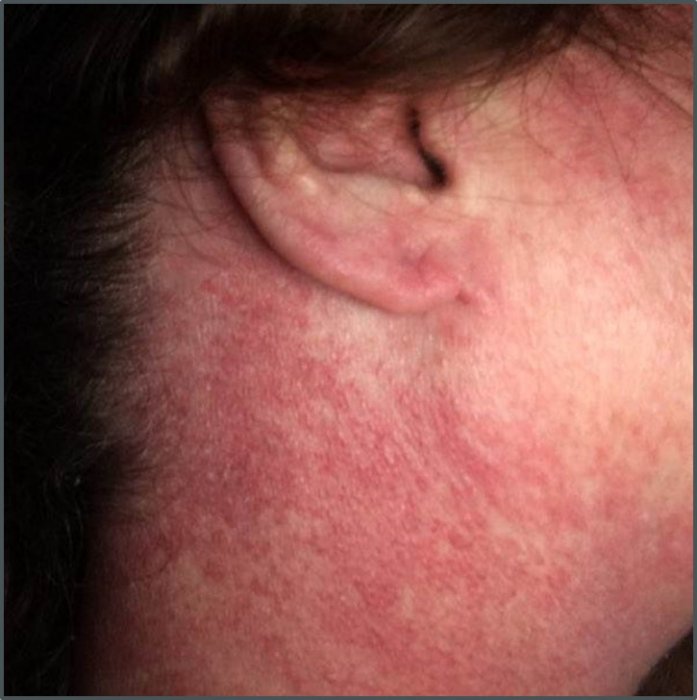CORRECT DIAGNOSIS:
Dermatomyositis
DISCUSSION:
Dermatomyositis (DM) is a rare autoimmune connective tissue disorder (AI-CTD) that can overlap with other AI-CTDs. The pathogenesis is incompletely understood but some theorize it could be a result of an infectious, drug, or malignant trigger in genetically predisposed individuals. Drugs such as statins and hydroxyurea are most commonly associated. Malignancies may precede or follow after diagnosis of DM and most often within 1 year of presentation. The most common malignancies include: breast, colon, lung and ovarian carcinoma. Incidence of DM ranges 2-9 per million and is more common females than males. There is a bimodal age distribution 5-14 years to 45-64, but unlike adult DM childhood DM is not associated with development of solid organ malignancies.
Classically DM causes proximal, symmetric extensor inflammatory myopathy with a cutaneous eruption. This disease can have numerous cutaneous findings that vary per patient though there are some that present more consistently like the heliotrope rash and gottron’s papules. The rash is often severely pruritic and may appear as poikiloderma on sun exposed areas. This poikiloderma is usually more violaceous than what is seen in lupus.
Similar to our case, there is a subset of patients without any discernible myopathy. These patients are both without muscle weakness or elevated muscle damage enzymes like CPK. They may have the same cutaneous findings and still have an increased likelihood of developing an underlying malignancy. In 13% of cases, amyopathic DM eventually develop myopathy.
Screening should always be performed to rule out any underlying malignancy. While there is no official guideline, age appropriate screening is often performed including mammograms, ultrasound, colonoscopy and basic blood work. Additional workup may include: CT chest, abdomen and pelvis, PSA, serum CA 125, urinalysis, and fecal occult blood. Regular follow up is recommended for at least 2-5 years as after this period malignancy risk returns back to levels seen in the general public.
TREATMENT:
For cutaneous disease treatment options include topical steroids, photoprotection, antimalarials, methotrexate, IVIG and oral calcineurin inhibitors.
For systemic myopathy consider systemic steroids, methotrexate, azathioprine, and cyclosporin.
REFERENCES:
Bendewald, M. J., Wetter, D. A., Li, X., & Davis, M. D. (2010). Incidence of dermatomyositis and clinically amyopathic dermatomyositis: A population-based study in Olmsted County, Minnesota. Archives of Dermatology, 146(1), 26–30. https://doi.org/10.1001/archdermatol.2010.9 [PMID: 20065119]
Marvi, U., et al. (2012). Clinical presentation and evaluation of dermatomyositis. Indian Journal of Dermatology, 57(5), 375–381. https://doi.org/10.4103/0019-5154.105646 [PMID: 23112380]
Gerami, P., Schope, J. M., McDonald, L., et al. (2006). A systematic review of adult-onset clinically amyopathic dermatomyositis (dermatomyositis sine myositis): A missing link within the spectrum of the idiopathic inflammatory myopathies. Journal of the American Academy of Dermatology, 54(4), 597–613. https://doi.org/10.1016/j.jaad.2005.09.035 [PMID: 16531304]
Bolognia, J., Jorizzo, J. L., & Schaffer, J. V. (2012). Dermatology. Philadelphia: Elsevier Saunders.
Aggarwal, R., & Oddis, C. V. (2012). Therapeutic advances in myositis. Current Opinion in Rheumatology, 24(6), 635-641. https://doi.org/10.1097/BOR.0b013e328359a9d5 [PMID: 22948778]
Park, S., & Im, D. (2017). Sphingosine 1-phosphate receptor modulators and drug discovery. Biomolecules & Therapeutics, 25(1), 80–90. https://doi.org/10.4062/biomolther.2017.085 [PMID: 28167881]
Leatham, H., & Schadt, C. (2018). Evidence supports blind screening for internal malignancy in dermatomyositis. Medicine, 97(2), e9650. https://doi.org/10.1097/MD.0000000000009650 [PMID: 29383082]
Lam, C., et al. (2012). Management of cutaneous dermatomyositis. Dermatologic Therapy, 25(2), 112–134. https://doi.org/10.1111/j.1529-8019.2012.01455.x [PMID: 22489839]
Baily, E., & Fiorentino, D. F. (2014). Amyopathic dermatomyositis: Definitions, diagnosis, and management. Current Rheumatology Reports, 16(10), 465. https://doi.org/10.1007/s11926-014-0465-0 [PMID: 25276370]
Kondo, M., et al. (2014). A case of overlap syndrome successfully treated with tocilizumab: A hopeful treatment strategy for refractory dermatomyositis? Rheumatology (Oxford), 53(10), 1907–1908. https://doi.org/10.1093/rheumatology/keu234 [PMID: 24845073]




